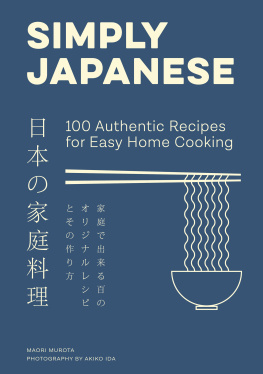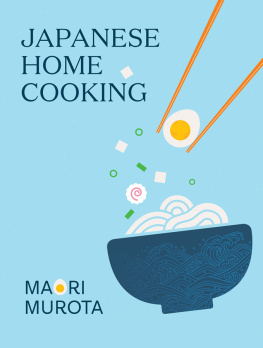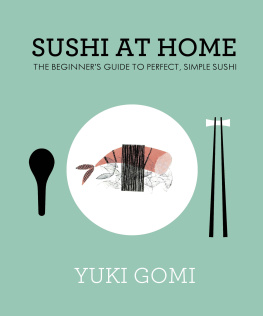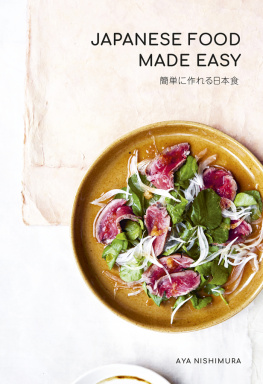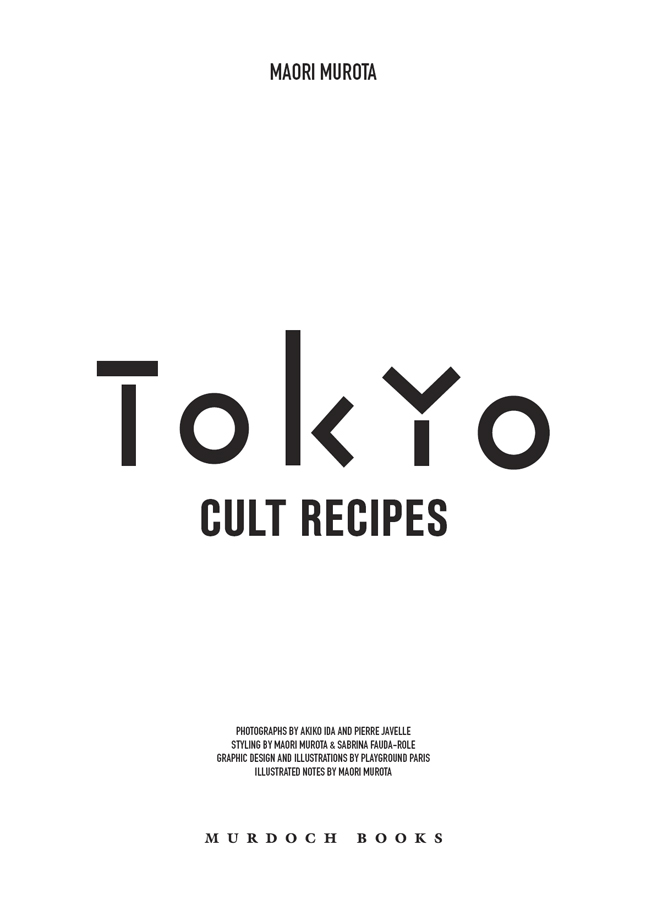MY MOTHERS RECIPE NOTEBOOK, STARTED WHEN I WAS BORN
PREFACE
When I arrived in France, I noticed that Japanese food wasnt very well understood here. It was often confused with other Asian cuisines, or else it had a fairly limited image. People would ask me: So, do you eat sushi every day at home? No, not all that often. It is more of a special occasion meal orchestrated by a sushi master at a restaurant. I dont like tofu, its bland. There are many ways of preparing tofu, and it is also important to choose the right tofu for each dish. Miso soup has no flavour. Its just salty. Make your miso soup with real dashi stock, and you are sure to change your mind! So I started giving cooking classes. Not just for sushi and yakitori, but also for the everyday dishes eaten in Japan. What a pleasure to hear the responses: Japanese cooking is so simple! There are a lot of flavours I didnt know about. What looked complicated isnt that hard! Yes, it is simple. You just need to learn a few basic techniques, and how to identify and use quality ingredients. Becoming a sushi master may not be within everyones reach, but everyday Japanese cooking is not difficult to learn. Born in Tokyo, I grew up there with parents who were passionate about food. My father, a real Tokyoite and proud of it, took me to all the restaurants he loved, from luxurious sushi restaurants at one end of the scale to yatai, the crude but incredibly good mobile yakitori stands at the other, with traditional soba noodle restaurants in the Asakusa district in between. My mother, equally enthusiastic about food, made a bento box for me every day to take to school. Or rather, she made the best bento of the class, the one everyone wanted to taste. At home we cooked together, and every meal was a topic of serious discussion! So, in this book, I want to introduce you to the authentic dishes of the Tokyo I grew up in the food cooked at home and the food served in restaurants. The recipes are drawn from my memory and the trip I made for this book, visiting my favourite neighbourhoods and going back to family sources. I hope this book will help you discover the true flavours of Tokyo and Japan. I will be delighted if it inspires your everyday cooking and gives you the pleasure of sharing it with someone!


CONTENTS
ASA TEISHOKU
BREAKFAST
The traditional Japanese breakfast is made up of rice, miso soup, tsukemono (pickles), fish and eggs. This meal is an integral part of Japanese cuisine because it contains the essential elements of our dishes, such as rice and dashi (stock). In day-to-day life, we dont always have time to make this traditional breakfast, instead having coffee, toast and pancakes in the Western style, but it is still very much enjoyed.
PREPARING RICE
Rice is an essential food for the Japanese. Not just a side dish, rice is as important as the rest of the meal. More than 300 varieties are grown, but those that are short-grained and high in starch are preferred. Japanese consumers take their choice of brand seriously and are prepared to spend money on expensive rice cookers to get the best results. For the Japanese, cooking the right rice perfectly is a passion.
These are the quantities of cooked rice to prepare according to the dish:
For 1 small bowl of rice to serve with a standard dish: 150 g (5 oz)
For 1 large bowl of rice for donburi (various toppings on a bed of rice): 280 g (10 oz)
For 1 sushi: 18 g ( oz)
For 1 large onigiri: 100 g (3 oz) for a small one: 60 g (2 oz)
For example, to make a donburi dish for 4 people, you will need about 1.1 kg (2 lb 7 oz) cooked rice. This corresponds to 450 g (1 lb) uncooked rice or, in traditional Japanese measurements, 3 g, which is equivalent to 540 ml (18 fl oz).
RICE PORTION SIZES
SERVES 4
300 g (12 oz), or 2 g, of Japanese white rice
430 ml (15 fl oz/1 cups) water
The g is a Japanese unit of measurement: 1 g equals 150 g (5 oz) or 180 ml (6 fl oz) of rice. The amount needed for a bowl of rice for 1 person is 75 g (2 oz), or 90 ml (3 fl oz), so 1 g is the ideal quantity for 2 people. To make this step easier, find a glass that holds 1 g youll need 1 and 1/5 glasses of water for each glass of rice. The weight of rice increases by 2.5 times when cooked, thus 75 g (2 oz) rice becomes about 190 g (6 oz).
PREPARATION
35 MINS PREPARATION TIME - 18 MINS COOKING TIME
1. Washing
Place the rice in a large bowl. Pour in some water and mix with your hands, then immediately discard the water (use a strainer to drain the rice). Next, sharpen the rice. This is the Japanese term for removing the excess starch by washing the grains. Cup your hand as if you were holding a baseball. Plunge your cupped hand into the rice and turn it about 20 times, tracing small circles. Pour some more water into the bowl; it will turn cloudy. Discard this water immediately and sharpen the rice again. Pour in some water and discard. Repeat this process 34 times until the water in the bowl is clear.
2. Draining
Drain the rice in a strainer and let it rest for 30 minutes.
3. Soaking in water
Place the rice in a heavy-based saucepan (or a flameproof casserole dish) with a lid, so the rice doesnt burn. Pour in the required amount of water. Let the rice soak briefly so it absorbs some water before cooking.
4. Cooking
Cover the saucepan and bring to the boil on a medium heat (about 5 minutes). Lower the heat to the minimum setting and cook for about 1213 minutes (avoid removing the lid after reducing the heat). Take off the heat and let the rice rest for 10 minutes. This ensures that the rice swells up properly. Remove the lid and use a spatula to stir the rice, going right to the bottom of the pan, without mashing the grains if the grains stick, wet the spatula.
TIPS
If you want to buy a rice cooker, choose a Japanese model if you can afford it, because Chinese rice cookers are generally designed to cook Chinese rice, which has lower levels of starch and water. If you are short on time, you can skip steps 2 and 3 (although the rice wont be as good), but never skip step 1 or the excess starch and any unpleasant taint wont be properly removed.


